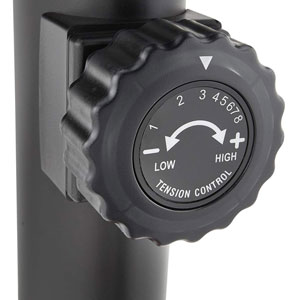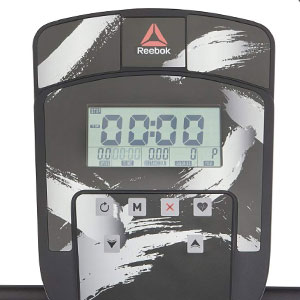| Unit | Size | Supported weight | Flywheel weight | Resistance | Console |
|---|---|---|---|---|---|
| Reebok ZJET 430 RVJF-12201RD  Check Discounted Price | L:43" W:20.5" H:55" | 265 lbs | 15.5 lbs | Manual magnetic, 8 levels | Time, Distance, Calories, Speed, RPM, Pulse, Goals, Recovery |
The Reebok ZJET 430 category includes several fitness machines; we’ve already reviewed the ZJET 430 elliptical, so to avoid any confusion with regards to the identity of this product, the ZJET 430 upright bike is the Reebok part number RVJF-12201RD.
This Reebok exercise bike is a model designed for home use. It is equipped with a manual resistance system and does not have preset programs. But nonetheless, it’s a durable bike, great for a variety of cardio workouts.
Key Features and Specifications
- Assembled dimensions: 43L x 20.5W x 55H inches (109L x 52W x 140H cm)
- Assembled weight: 72.7 lbs (33 kg)
- Supported weight: 265 lbs (120 kg)
- Flywheel weight: 15.5 lbs (7 kg)
- Seat: 4-way adjustable
- Resistance: Manual magnetic, 8 levels
- Console: Time, distance, speed, RPM, calories, pulse, goals, Recovery
- Extras: Tablet holder, bottle holder
Frame construction
The Reebok ZJET 430 upright exercise bike features a steel frame with ABS protective covers for the drive and  resistance elements. All the steel parts are coated with a corrosion-resistant paint finish black in color, with the exception of the seat post which is chrome-coated.
resistance elements. All the steel parts are coated with a corrosion-resistant paint finish black in color, with the exception of the seat post which is chrome-coated.
The bike has a pretty durable construction for a home-use unit. It is designed to support users up to 265 lbs (120 kg). It is also fairly heavy. With all the parts assembled, it weighs approx. 72.3 lbs (33 kg) which is almost twice the weight of the average road bike. All this weight is reflected in the bike’s overall stability.
In terms of stability, the bike is also equipped with four adjustable levelers, two on the rear base bar and two on the front base bar. These rest on rubberized pads to prevent floor damage. Plus, the front base features a set of transport wheels which considerably ease the relocation of the fully assembled unit.
Like most other upright bikes, the ZJET 430 isn’t extremely large. It is approx. 43″ (109 cm) long, and 20.5″ (52 cm) wide, while its maximum height reaches approx. 55″ (140 cm) above floor level.
The bike doesn’t have a step-through design, like the Tunturi Competence F40, for example. Therefore, taking position on the seat may be a bit difficult for users with certain disabilities. But nonetheless, passing one foot over the bottom frame unit shouldn’t be too difficult for any user.
Seat and handlebars
The Reebok ZJET 430 upright bike includes a pretty standard seat. Its top integrates a layer of padding, also  being contoured with a central groove for extra breathability. The saddle is pretty firm but does have a bit of flexibility in order to adapt better to the user’s movement during pedaling. In all, the bike’s seat is designed to provide optimal comfort.
being contoured with a central groove for extra breathability. The saddle is pretty firm but does have a bit of flexibility in order to adapt better to the user’s movement during pedaling. In all, the bike’s seat is designed to provide optimal comfort.
The saddle features a collar-based attachment system to its slider. Due to this aspect, you can easily remove it or slightly adjust its angle if necessary. It also makes the bike compatible with a wide variety of seats.
The bike’s seat offers four-way adjustability (up, down, forward, backward). Its upright post has several adjustment positions while its horizontal slider provides a few more inches of front to back adjustment. Therefore, the bike can accommodate users with an inseam between 22″ and 34″ (55 – 85 cm). In other words, it should fit users between 5’0″ – 6’2″ (153 – 188 cm) with no problem, providing a complete range of motion.
The bike’s handlebar has a multi-grip design. It is fully covered by a layer of rubber foam material for a superior grip. Also, its side grips have pulse sensors, a feature that other upright bikes don’t offer.
The height of the handlebar is non-adjustable. In other words, you cannot adjust the main front post of the unit. However, you can adjust the angle of the handlebar. It attaches to the post via a knob which can be easily un-tightened and re-tightened.
Drive and resistance
The Reebok ZJET 430 features a mid-range 15.5 lbs (7 kg) flywheel. This element has a perimeter-weighted  structure and provides a bit of extra inertia and a more consistent pedaling motion. The flywheel also allows reverse pedaling, so you can diversify your workouts. Also, when pedaling in reverse, the console continues to monitor distance traveled and the other metrics.
structure and provides a bit of extra inertia and a more consistent pedaling motion. The flywheel also allows reverse pedaling, so you can diversify your workouts. Also, when pedaling in reverse, the console continues to monitor distance traveled and the other metrics.
The bike is equipped with a sturdy crankset featuring crank arms similar to a road bike. However, since it’s an upright exercise bike, standing on the pedals while leveling is not recommended.
The pedals have a weighted design; therefore, if you remove your feet from them, they will always turn face-up, allowing you to easily re-place your feet on them. They have a non-slip surface and adjustable straps for extra foot stability.
The internal drivetrain uses a heavy-duty poly-v belt. This being said, the pedaling motion is very smooth and quiet. Also, you don’t have to take the ABS covers apart to lubricate the transmission as it would be the case for a chain drive.
The ZJET 430 exercise bike features a manual magnetic resistance system. This means it doesn’t have an internal motor and does not need to be connected to a power source. Also, the console does not control the resistance in any way.
The bike’s resistance system consists of an internal magnetic brake attached to the flywheel system and connected to the tension knob on the front mast through a steel cable. Thus, when you turn the knob, the magnetic brake moves closer or farther from the flywheel, increasing or decreasing the resistance. The resistance elements do no touch, so there is no friction, which leads to a very smooth pedaling motion.
Like most other upright bikes with a manual magnetic resistance system, the ZJET 430 makes available 8 distinct tension levels. The first level delivers little resistance, promoting a light cardio workout, great for recovery training. The 7-8 tension levels are considerably more difficult though, simulating a hill climb.
Console
As we’ve mentioned above, the bike has a manual resistance system so the console cannot automatically change the resistance as for other motorized bikes. It also doesn’t have preset workout programs or online connectivity.
the resistance as for other motorized bikes. It also doesn’t have preset workout programs or online connectivity.
The console unit features an LCD display which is split into several sub-sections in order to show all the workout metrics at once so you won’t have to scroll through them all the time. It tracks time, distance, speed, RPM, calories, and pulse. The unit is not telemetric, though. It can only read your pulse if you keep your hands on the grip sensors integrated into the handlebar. It cannot communicate with an ANT or Polar HR chest strap.
Although the console does not offer preset workout programs, it does offer goal setting functions and a Recovery function. You can set up goals for time, distance, speed, and calories. When a goal value is set for time, distance, or calories, the monitor will display the remaining value until the goal completion. When a target is selected for speed, the monitor will prompt you to pedal faster or slower, depending on the selected target and your pedaling speed.
The Recovery function requires the usage of the pulse sensors. This function detects how long it takes your pulse to return to normal after the workout, and based on the result, it gives you a fitness rating between F1 (excellent) and F6 (poor).
The console unit uses two AA batteries as its power source. It has a sleep mode into which it will enter after four minutes of inactivity on the bike. When in sleep mode, the monitor will display the room temperature. To wake it up, you can either begin pedaling or press any button.
Assembly and Maintenance
The main body of the bike comes pre-assembled. You only have to attach the two base bars, the front mast, the console, the handlebars, the seat, and the pedals. This shouldn’t take more than 40 minutes. A set of basic tools is included, and the manual provides all the necessary instructions and illustrations.
Maintenance doesn’t require much. All the internal components are pre-lubricated from the factory, and since the bike has a belt drive system, it doesn’t require any lubrication. Thus, for maintenance, all you have to do is wipe the dust from the frame and periodically check for loose parts and bolts.
The Pros
- Sturdy frame – can support users up to 265 lbs (120 kg);
- Adjustable stabilizers on both bases;
- Transport wheels on the front base;
- Multi-grip and angle adjustable handlebar;
- Pulse sensors integrated into the handlebar;
- 4-way adjustable seat;
- Balanced flywheel for a steady pedaling motion;
- Quiet belt drive;
- Zero friction magnetic resistance;
- 8 resistance settings;
- Weighted pedals with adjustable straps;
- Large LCD display on the console divided into multiple sub-sections;
- The console tracks time, distance, speed, calories, RPM, and pulse;

- Goal selection for time, distance, speed, and calories;
- Recovery function;
- Tablet holder included;
- Bottle holder included;
- Little maintenance required;
- Easy to assemble.
The Cons
- No backlight on the exercise meter;
- A tablet placed on the tablet holder will cover the console display.
Summary
The Reebok ZJET 430 is an upright exercise bike made for home use. It is equipped with a manual magnetic resistance system featuring 8 difficulty levels, a 15.5 lbs internal flywheel, and a console which can track the main workout metrics. It also has a pulse reading function. It’s a trainer designed for light to mid-range cardio workouts, recovery training, muscle toning, and weight loss. In all, it’s a decent exercise bike, offering excellent value for the price.

